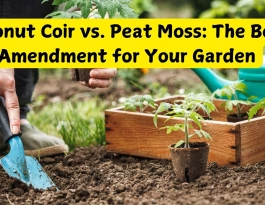Dealing with Ants in Palm Trees? Here’s How to Stop the Infestation
One sunny morning, I noticed a trail of ants in palm tree of my garden. I didn’t know whether it was normal or if I should do something about it. Then I asked my garden enthusiast professor about it.
She shared that while ants can be beneficial, excessive infestations might harm the tree. Also, she advised monitoring the situation and, if needed, using natural repellent for ants. So, I thought I should tell you everything you need to do in such ants in palm tree situation.
Is it Normal for Ants to be on Tree?
Yes, it’s quite normal to find ants on trees, as long as their presence is in moderation and not causing harm to the tree itself. Ants are natural inhabitants of many ecosystems and can play essential roles in the environment.
They are known to feed on other insects, helping to control pest populations in and around trees. Ants also have mutualistic relationships with certain tree-dwelling insects like aphids, where they protect them in exchange for honeydew, a sugary substance excreted by the aphids.
In this way, ants can indirectly benefit trees by keeping other pests in check. However, if you notice an excessive number of ants on a tree or signs of damage to the tree, it may indicate an ant infestation that needs attention.
Some ant species can be harmful when they build nests in the wood or bark of trees, potentially causing structural damage or weakening the tree.
Why Do Ants Attack Palm Tree?
Ants may attack palm trees for various reasons, often associated with their natural behavior and ecological interactions within the tree’s ecosystem. Here’s an elaborate explanation of why ants might be drawn to palm trees:
Hunting for Honeydew
Ants are known to have mutualistic relationships with sap-feeding insects like aphids, scales, and mealybugs. These insects feed on the sap of palm trees and excrete a sugary substance called honeydew, which ants find highly attractive. Ants “farm” these honeydew-producing insects, protecting them from predators and other threats in exchange for a continuous supply of honeydew. Thus, ants often climb palm trees to access this sweet food source.
Shelter and Nesting Sites
Palm trees, particularly those with cavities, rotting wood, or expired fronds, can provide suitable nesting sites for certain ant species. Ants are known to nest in tree crevices, fallen fronds, or within the fibrous structure of palm trees. These locations offer protection from environmental factors and predators, making them attractive to ant colonies.
Scavenging for Food
In addition to honeydew, ants are opportunistic scavengers and foragers. They are attracted to any potential food sources that might be present on or near the palm tree, including fallen fruit, lost insects, and other organic matter. Their relentless search for food can lead them to explore and establish ants nest in trees.
Symbiotic Relationships
Some palm tree pests, like scale insects, can form mutualistic relationships with ants. These pests provide honeydew as a food source for the ants, while the ants protect them from natural predators. This mutualism can lead to ant infestations on palm trees as the ants actively defend their “herds” of honeydew-producing insects.
Moisture and Protection
Ants are also attracted to moisture sources, especially in arid regions. Palm trees often have water-holding cavities or crevices created by expired fronds, making them attractive to ants seeking hydration. Additionally, the presence of ants can deter certain herbivores and predators, providing indirect protection to the palm tree.

How to Get Rid of Ants in Palm Tree
Getting rid of ants in a palm tree can be a challenging but necessary task to ensure the tree’s health and prevent potential damage. Here’s an elaborate guide on how to effectively eliminate ants from your palm tree:
Identify the Ant Species
- Before proceeding with ant control methods, try to identify the specific ant species infesting your palm tree. Different species may respond differently to bait and insecticides.
Ant Bait Traps
- Wait until the soil around the palm tree has dried out to prevent moisture from affecting the bait.
- Place ant bait traps at the bottom of the pot or near the base of the tree where you’ve observed the most ant activity.
- Follow the label instructions for the bait traps. Some traps may require cutting open to release the attractant.
- Avoid watering the palm tree for a few days to keep the bait traps dry. Even ants are deterred by soggy food.
- If the potted palm is outdoors, move it to a location where it won’t be exposed to rain.
Observe and Reapply Bait
- Wait for some time to see if the ants have taken the bait back to their nest. This may take several days or even weeks.
- If the ant activity persists, continue to lay fresh bait traps until the entire ant colony has been eliminated.
- Keep in mind that not all ant baits work for all ant species. If the initial bait fails, try to identify the species and find a bait specific to that variety.
Use Insecticides Sparingly
- While insecticides can provide immediate relief from ant infestations, they won’t eliminate the problem at its source unless you locate and destroy the nest.
- If baits have not worked after at least a week, consider using an ant-repelling barrier product.
- Spray the potted palm and its container with an ant-repelling barrier product. If the tree is outdoors, treat the surrounding area as well.
Tree-Specific Solutions
- Use Termidor SC sparingly and carefully to target the ant nest if you can locate it.
- Spread ant bait around the base of the palm tree.
- Employ horticultural soap or insecticide to rid the tree of sap-feeding insects, which may be attracting the ants.
Ant Powder
- Applying ant powder around the base of the tree can be an effective and easy method to deal with tree-infesting ants.
Permethrin Solution
- Prepare a permethrin solution by mixing one teaspoon of permethrin with one gallon of water.
- Soak the ant nest and the area around the tree’s roots.
If you’ve successfully eliminated ants from your garden, you might also be interested in understanding the differences between roly polys and pill bugs, two common garden dwellers.
Home Remedies for Excessive Ants in Palm Tree
If you’re dealing with excessive ants in your palm tree and prefer to use home remedies before resorting to chemical solutions, you should go for a natural way to repell ants:
- Diatomaceous Earth: Sprinkle food-grade diatomaceous earth around the base of the palm tree and on the trunk. Diatomaceous earth is a natural, abrasive substance that can damage ants’ exoskeletons, causing them to dehydrate and die. Reapply after rain or watering.
- Vinegar Solution: Mix equal parts white vinegar and water in a spray bottle. Spray this solution on the trunk and branches of the palm tree. The strong scent of vinegar can deter ants. Reapply as needed, especially after rainfall.
- Cinnamon: Sprinkle ground cinnamon around the base of the palm tree. Cinnamon has a strong odor that ants dislike and can help deter them from climbing the tree.
- Peppermint Oil: Create a peppermint oil spray by mixing a few drops of peppermint essential oil with water. Spray this mixture on and around the palm tree. Peppermint oil has a strong scent that repels ants.
- Boiling Water: Pour boiling water directly onto ant nests at the base of the palm tree. This method can help eliminate the ant colony, but it may harm beneficial soil organisms, so use it sparingly.
- Molasses and Borax: Mix molasses with borax to create a paste. Place small amounts of this mixture near ant trails or at the base of the tree. Ants are attracted to the molasses but will ingest the borax, which is toxic to them.
- Soap and Water: Create a soapy water solution by mixing liquid dish soap with water. Spray this solution on the ants directly to disrupt their ability to breathe through their exoskeletons. This method is best for dealing with ants on the tree’s trunk and branches.

Prevention Strategies to Avoid Ants in Palm Tree
Keeping ants away from your palm tree is fundamental for maintaining its health and preventing re-infestation. Here’s how you can deter ants in palm trees effectively:
Strengthen Your Palm Tree’s Health
A strong, well-nourished palm tree is less likely to attract ants. Ensure proper watering, fertilization, and pruning to minimize stress and vulnerability to pests.
Conduct Routine Tree Inspections
Check for ant trails, nests, and signs of sap-feeding insects like aphids and scales. Early detection allows for swift, organic pest control.
Eliminate Ant Attractants
Regularly clean up fallen fruit, dead fronds, and organic debris around your palm tree. Keeping the area tidy removes food sources and potential nesting sites.
Trim Overgrown Foliage
Prune excess fronds and branches to reduce access points and hiding spots for ants. This also improves air circulation, lowering excess moisture levels.
Seal Entry Points
Check for cracks or holes in the tree trunk and seal them with tree-safe sealants or natural wound dressings to block ants from nesting inside.
Apply Physical Barriers
Use sticky tree wraps, diatomaceous earth, or plant-based repellents around the trunk to prevent ants from climbing up.
Introduce Natural Predators
Encourage garden-friendly insects like ladybugs and lacewings, which help manage pest populations that attract ants.
Use Beneficial Nematodes
Apply soil-friendly nematodes to target and control larvae naturally, preventing future infestations without harming the environment.
Spray Neem Oil Regularly
Neem oil is a tree-friendly insect repellent that disrupts pest activity. Mix it with water and spray on leaves, trunks, and surrounding soil.
Avoid Overwatering and Over-Fertilizing
Excess moisture and high nitrogen levels can create conditions favorable to insects. Stick to recommended palm tree care guidelines to prevent overgrowth and pest attraction.
Monitor Neighboring Plants
Check nearby vegetation for pest activity since infestations can spread between plants. Early intervention ensures effective tree pest management.
Refresh Barriers Periodically
If you’ve set up natural deterrents like sticky bands or repellents, inspect and reapply them regularly to maintain their effectiveness.
By following these eco-friendly strategies, you can protect your palm trees from ant infestations while keeping your garden naturally balanced.
FAQs
Are there specific ant species that are more likely to infest palm trees?
Yes, some ant species, like Argentine ants and carpenter ants, are commonly associated with palm tree infestations. Identifying the specific ant species can help in choosing the most effective control methods.
How can I tell if my palm tree has an ant infestation?
Signs of an ant infestation include visible ant trails on the tree, the presence of ant nests, or the occurrence of aphids or scales, which ants “farm” for honeydew. You may also notice damage to the tree’s leaves or bark.
How long does it take to get rid of an ant infestation in a palm tree?
The time it takes to eliminate an ant infestation can vary based on factors like the size of the colony and the chosen control method. It may take several weeks to see significant results, so be patient and monitor progress.
Similarly, just as you’ve explored the impact of ants on your garden, it’s essential to understand the role of rolly pollies in your garden ecosystem.





